Strategic Change Implementation and its Impact on Organizations
VerifiedAdded on 2022/09/05
|8
|1770
|17
Report
AI Summary
This report delves into the critical aspects of strategic change implementation within organizations. It begins by introducing the concept of strategic change and its importance in adapting to market dynamics. The report examines the issues of strategic alignment, including the challenges posed by change rate, business scope, and disruptions. It explores the components of strategic change, emphasizing long-term goals and the implementation of strategies. The report further analyzes different areas of strategic alignment, such as business models and organizational systems, and the paradox of revolution and evolution. A practical application is provided through a case study of COSCO Shipping, illustrating how the company leverages strategic change for growth and global expansion. The report concludes with lessons learned, emphasizing the significance of strategic change in managing organizational adaptation, planning, and achieving long-term sustainability.
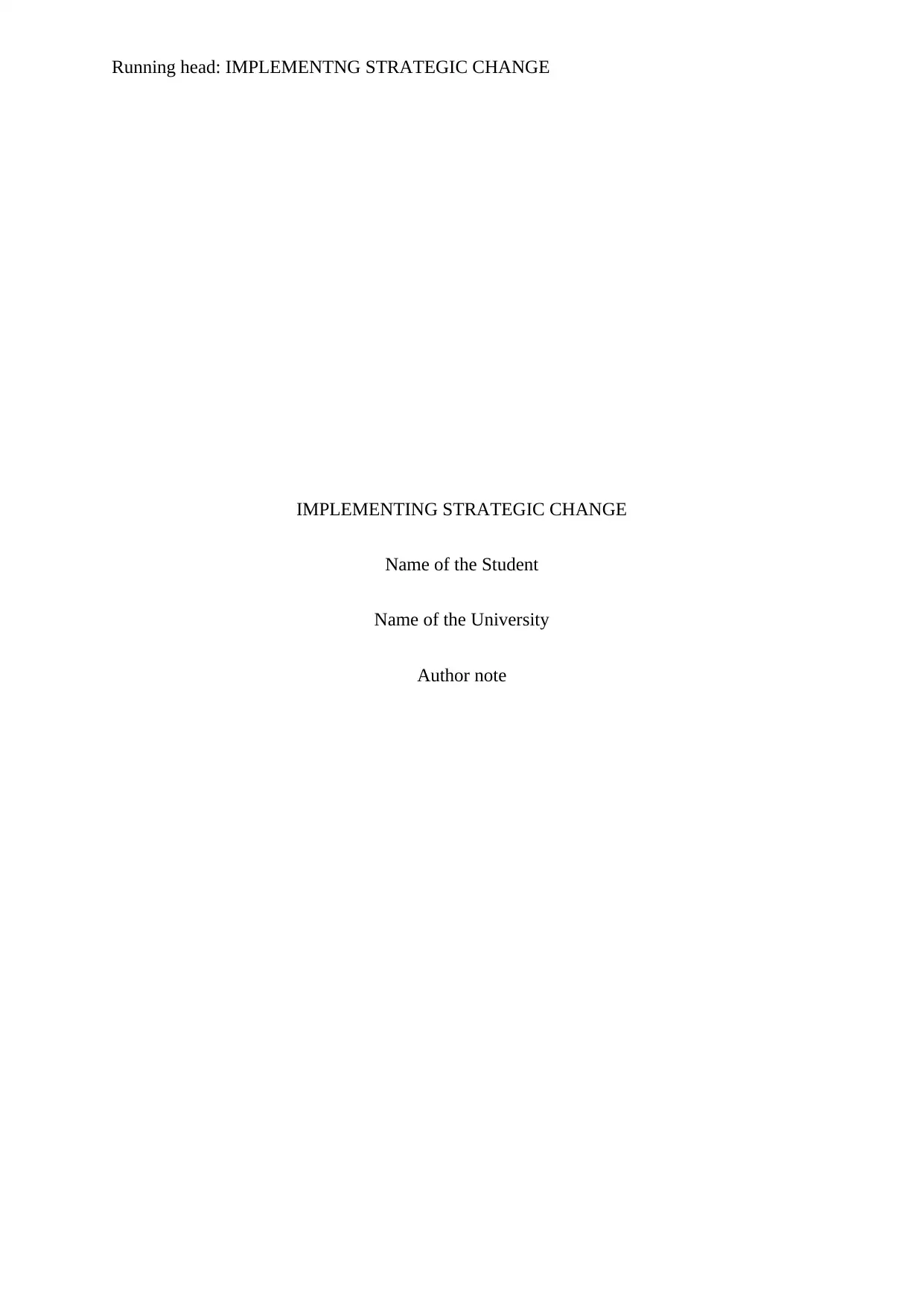
Running head: IMPLEMENTNG STRATEGIC CHANGE
IMPLEMENTING STRATEGIC CHANGE
Name of the Student
Name of the University
Author note
IMPLEMENTING STRATEGIC CHANGE
Name of the Student
Name of the University
Author note
Paraphrase This Document
Need a fresh take? Get an instant paraphrase of this document with our AI Paraphraser
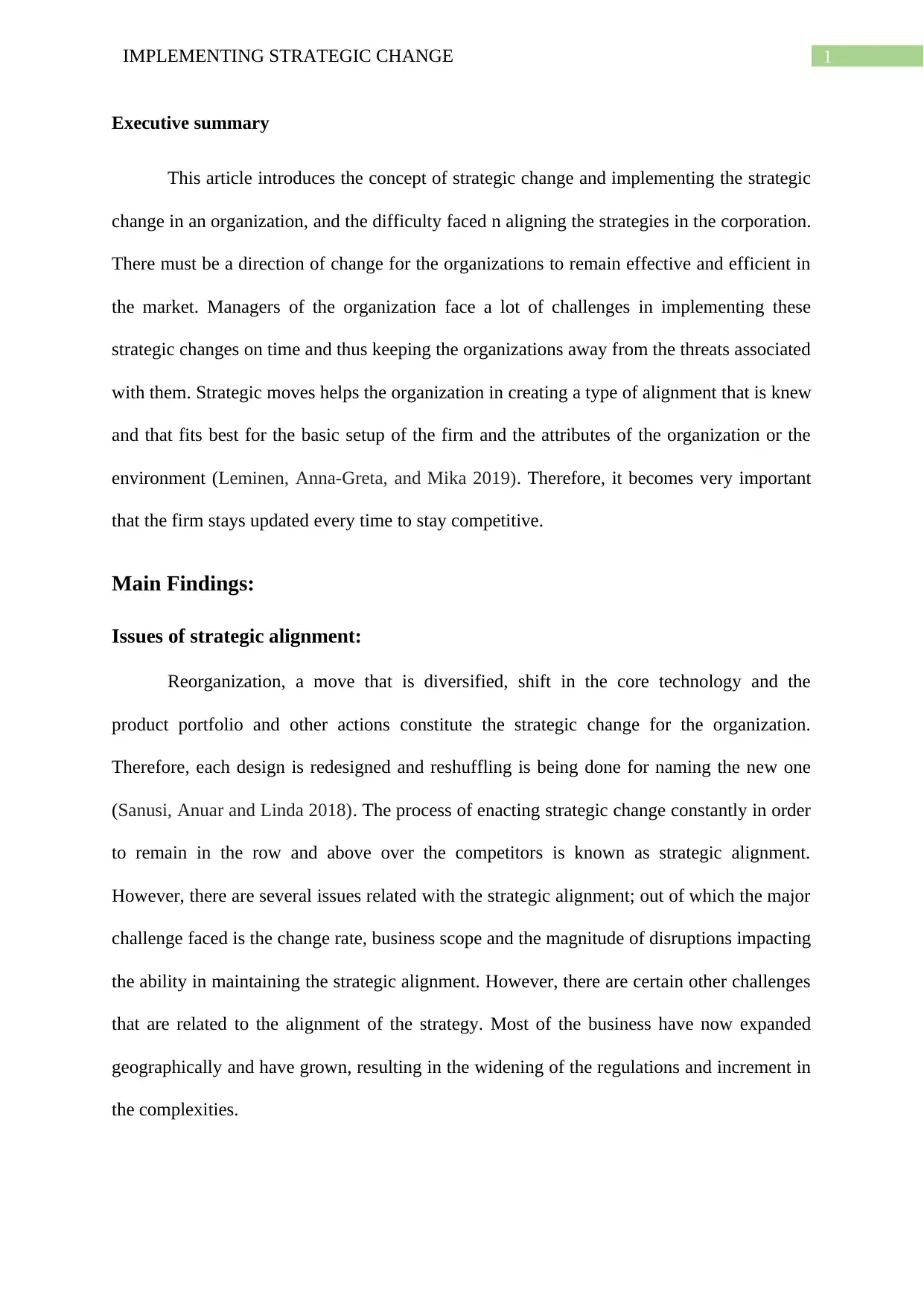
1IMPLEMENTING STRATEGIC CHANGE
Executive summary
This article introduces the concept of strategic change and implementing the strategic
change in an organization, and the difficulty faced n aligning the strategies in the corporation.
There must be a direction of change for the organizations to remain effective and efficient in
the market. Managers of the organization face a lot of challenges in implementing these
strategic changes on time and thus keeping the organizations away from the threats associated
with them. Strategic moves helps the organization in creating a type of alignment that is knew
and that fits best for the basic setup of the firm and the attributes of the organization or the
environment (Leminen, Anna-Greta, and Mika 2019). Therefore, it becomes very important
that the firm stays updated every time to stay competitive.
Main Findings:
Issues of strategic alignment:
Reorganization, a move that is diversified, shift in the core technology and the
product portfolio and other actions constitute the strategic change for the organization.
Therefore, each design is redesigned and reshuffling is being done for naming the new one
(Sanusi, Anuar and Linda 2018). The process of enacting strategic change constantly in order
to remain in the row and above over the competitors is known as strategic alignment.
However, there are several issues related with the strategic alignment; out of which the major
challenge faced is the change rate, business scope and the magnitude of disruptions impacting
the ability in maintaining the strategic alignment. However, there are certain other challenges
that are related to the alignment of the strategy. Most of the business have now expanded
geographically and have grown, resulting in the widening of the regulations and increment in
the complexities.
Executive summary
This article introduces the concept of strategic change and implementing the strategic
change in an organization, and the difficulty faced n aligning the strategies in the corporation.
There must be a direction of change for the organizations to remain effective and efficient in
the market. Managers of the organization face a lot of challenges in implementing these
strategic changes on time and thus keeping the organizations away from the threats associated
with them. Strategic moves helps the organization in creating a type of alignment that is knew
and that fits best for the basic setup of the firm and the attributes of the organization or the
environment (Leminen, Anna-Greta, and Mika 2019). Therefore, it becomes very important
that the firm stays updated every time to stay competitive.
Main Findings:
Issues of strategic alignment:
Reorganization, a move that is diversified, shift in the core technology and the
product portfolio and other actions constitute the strategic change for the organization.
Therefore, each design is redesigned and reshuffling is being done for naming the new one
(Sanusi, Anuar and Linda 2018). The process of enacting strategic change constantly in order
to remain in the row and above over the competitors is known as strategic alignment.
However, there are several issues related with the strategic alignment; out of which the major
challenge faced is the change rate, business scope and the magnitude of disruptions impacting
the ability in maintaining the strategic alignment. However, there are certain other challenges
that are related to the alignment of the strategy. Most of the business have now expanded
geographically and have grown, resulting in the widening of the regulations and increment in
the complexities.
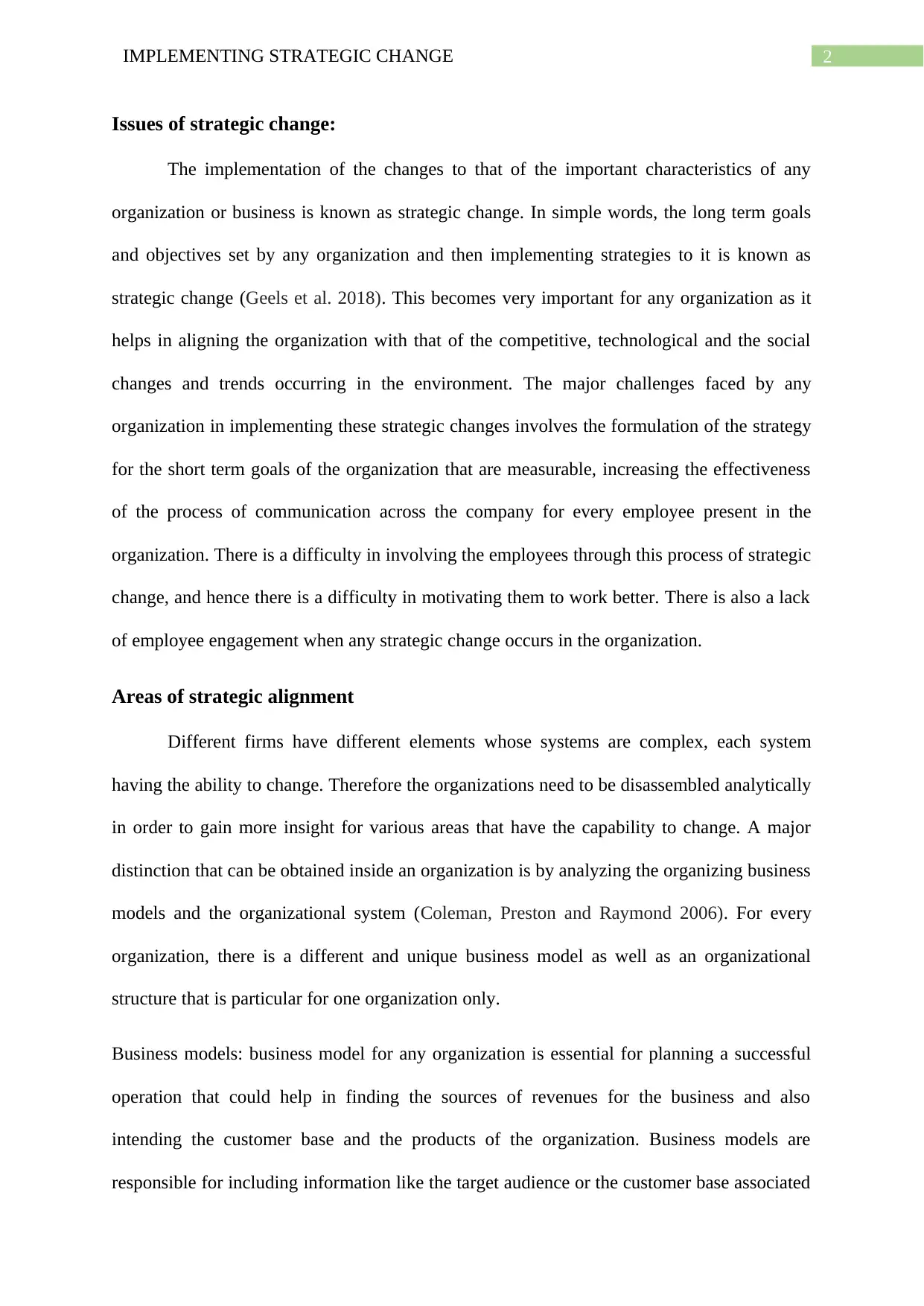
2IMPLEMENTING STRATEGIC CHANGE
Issues of strategic change:
The implementation of the changes to that of the important characteristics of any
organization or business is known as strategic change. In simple words, the long term goals
and objectives set by any organization and then implementing strategies to it is known as
strategic change (Geels et al. 2018). This becomes very important for any organization as it
helps in aligning the organization with that of the competitive, technological and the social
changes and trends occurring in the environment. The major challenges faced by any
organization in implementing these strategic changes involves the formulation of the strategy
for the short term goals of the organization that are measurable, increasing the effectiveness
of the process of communication across the company for every employee present in the
organization. There is a difficulty in involving the employees through this process of strategic
change, and hence there is a difficulty in motivating them to work better. There is also a lack
of employee engagement when any strategic change occurs in the organization.
Areas of strategic alignment
Different firms have different elements whose systems are complex, each system
having the ability to change. Therefore the organizations need to be disassembled analytically
in order to gain more insight for various areas that have the capability to change. A major
distinction that can be obtained inside an organization is by analyzing the organizing business
models and the organizational system (Coleman, Preston and Raymond 2006). For every
organization, there is a different and unique business model as well as an organizational
structure that is particular for one organization only.
Business models: business model for any organization is essential for planning a successful
operation that could help in finding the sources of revenues for the business and also
intending the customer base and the products of the organization. Business models are
responsible for including information like the target audience or the customer base associated
Issues of strategic change:
The implementation of the changes to that of the important characteristics of any
organization or business is known as strategic change. In simple words, the long term goals
and objectives set by any organization and then implementing strategies to it is known as
strategic change (Geels et al. 2018). This becomes very important for any organization as it
helps in aligning the organization with that of the competitive, technological and the social
changes and trends occurring in the environment. The major challenges faced by any
organization in implementing these strategic changes involves the formulation of the strategy
for the short term goals of the organization that are measurable, increasing the effectiveness
of the process of communication across the company for every employee present in the
organization. There is a difficulty in involving the employees through this process of strategic
change, and hence there is a difficulty in motivating them to work better. There is also a lack
of employee engagement when any strategic change occurs in the organization.
Areas of strategic alignment
Different firms have different elements whose systems are complex, each system
having the ability to change. Therefore the organizations need to be disassembled analytically
in order to gain more insight for various areas that have the capability to change. A major
distinction that can be obtained inside an organization is by analyzing the organizing business
models and the organizational system (Coleman, Preston and Raymond 2006). For every
organization, there is a different and unique business model as well as an organizational
structure that is particular for one organization only.
Business models: business model for any organization is essential for planning a successful
operation that could help in finding the sources of revenues for the business and also
intending the customer base and the products of the organization. Business models are
responsible for including information like the target audience or the customer base associated
⊘ This is a preview!⊘
Do you want full access?
Subscribe today to unlock all pages.

Trusted by 1+ million students worldwide
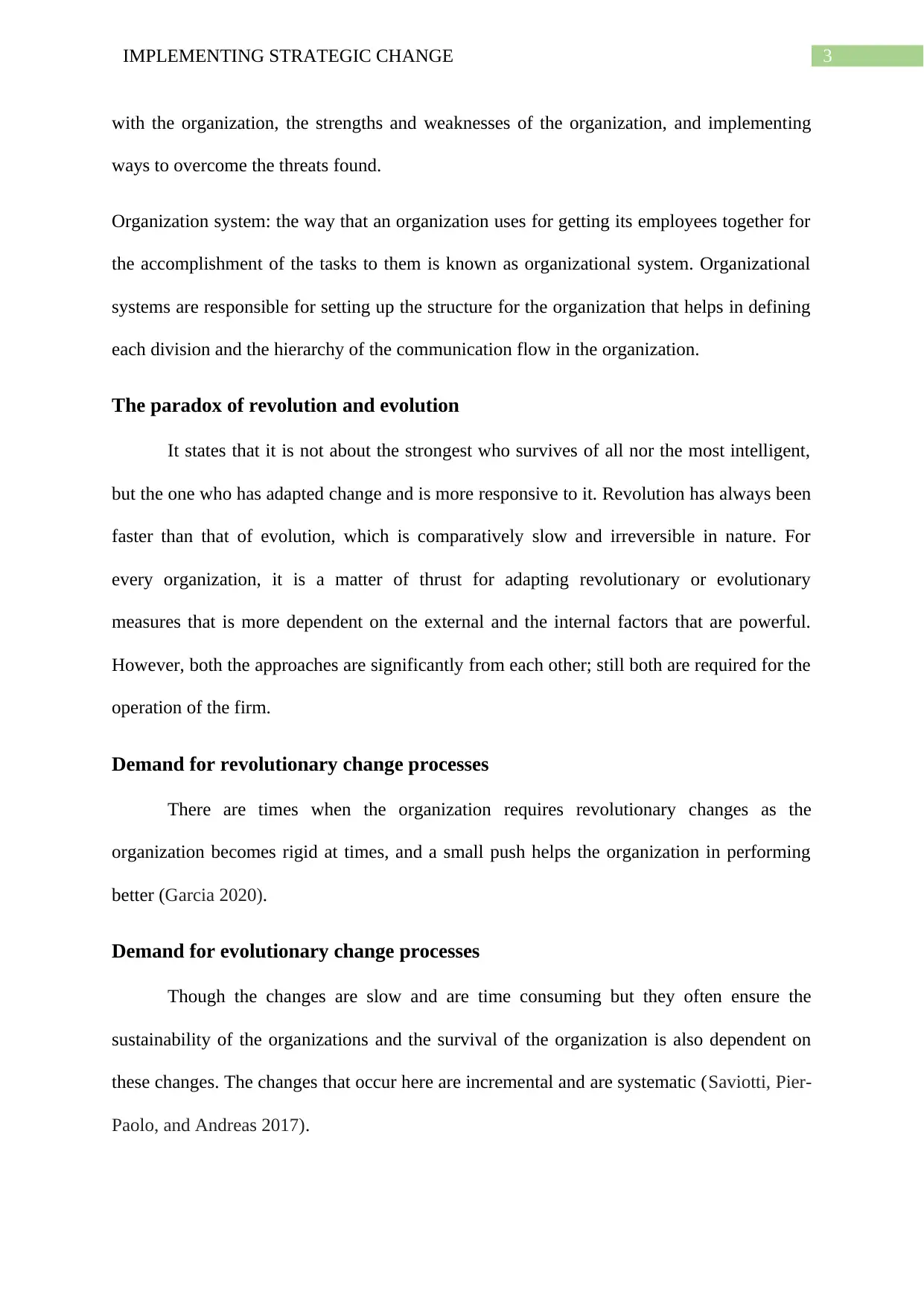
3IMPLEMENTING STRATEGIC CHANGE
with the organization, the strengths and weaknesses of the organization, and implementing
ways to overcome the threats found.
Organization system: the way that an organization uses for getting its employees together for
the accomplishment of the tasks to them is known as organizational system. Organizational
systems are responsible for setting up the structure for the organization that helps in defining
each division and the hierarchy of the communication flow in the organization.
The paradox of revolution and evolution
It states that it is not about the strongest who survives of all nor the most intelligent,
but the one who has adapted change and is more responsive to it. Revolution has always been
faster than that of evolution, which is comparatively slow and irreversible in nature. For
every organization, it is a matter of thrust for adapting revolutionary or evolutionary
measures that is more dependent on the external and the internal factors that are powerful.
However, both the approaches are significantly from each other; still both are required for the
operation of the firm.
Demand for revolutionary change processes
There are times when the organization requires revolutionary changes as the
organization becomes rigid at times, and a small push helps the organization in performing
better (Garcia 2020).
Demand for evolutionary change processes
Though the changes are slow and are time consuming but they often ensure the
sustainability of the organizations and the survival of the organization is also dependent on
these changes. The changes that occur here are incremental and are systematic (Saviotti, Pier-
Paolo, and Andreas 2017).
with the organization, the strengths and weaknesses of the organization, and implementing
ways to overcome the threats found.
Organization system: the way that an organization uses for getting its employees together for
the accomplishment of the tasks to them is known as organizational system. Organizational
systems are responsible for setting up the structure for the organization that helps in defining
each division and the hierarchy of the communication flow in the organization.
The paradox of revolution and evolution
It states that it is not about the strongest who survives of all nor the most intelligent,
but the one who has adapted change and is more responsive to it. Revolution has always been
faster than that of evolution, which is comparatively slow and irreversible in nature. For
every organization, it is a matter of thrust for adapting revolutionary or evolutionary
measures that is more dependent on the external and the internal factors that are powerful.
However, both the approaches are significantly from each other; still both are required for the
operation of the firm.
Demand for revolutionary change processes
There are times when the organization requires revolutionary changes as the
organization becomes rigid at times, and a small push helps the organization in performing
better (Garcia 2020).
Demand for evolutionary change processes
Though the changes are slow and are time consuming but they often ensure the
sustainability of the organizations and the survival of the organization is also dependent on
these changes. The changes that occur here are incremental and are systematic (Saviotti, Pier-
Paolo, and Andreas 2017).
Paraphrase This Document
Need a fresh take? Get an instant paraphrase of this document with our AI Paraphraser
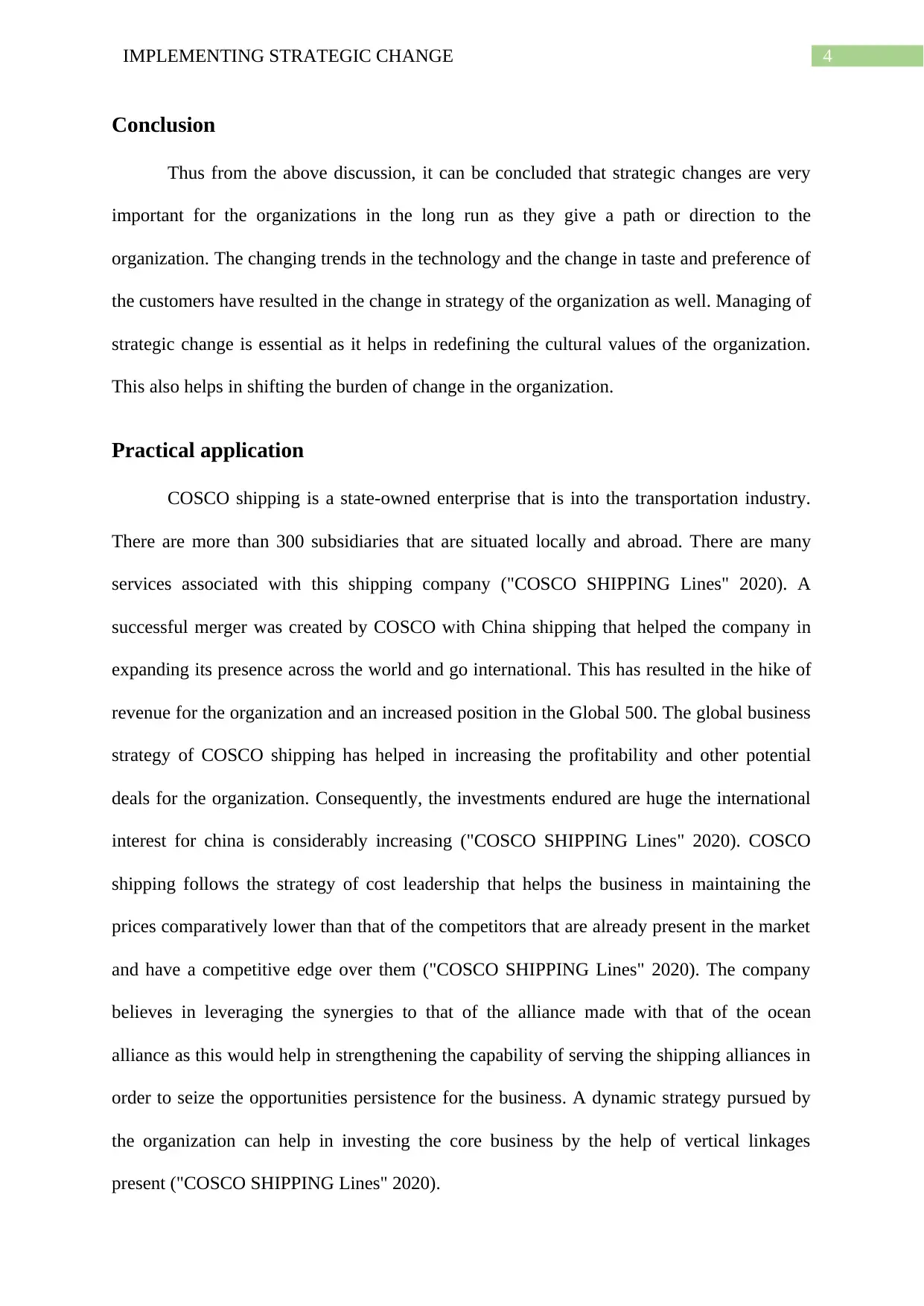
4IMPLEMENTING STRATEGIC CHANGE
Conclusion
Thus from the above discussion, it can be concluded that strategic changes are very
important for the organizations in the long run as they give a path or direction to the
organization. The changing trends in the technology and the change in taste and preference of
the customers have resulted in the change in strategy of the organization as well. Managing of
strategic change is essential as it helps in redefining the cultural values of the organization.
This also helps in shifting the burden of change in the organization.
Practical application
COSCO shipping is a state-owned enterprise that is into the transportation industry.
There are more than 300 subsidiaries that are situated locally and abroad. There are many
services associated with this shipping company ("COSCO SHIPPING Lines" 2020). A
successful merger was created by COSCO with China shipping that helped the company in
expanding its presence across the world and go international. This has resulted in the hike of
revenue for the organization and an increased position in the Global 500. The global business
strategy of COSCO shipping has helped in increasing the profitability and other potential
deals for the organization. Consequently, the investments endured are huge the international
interest for china is considerably increasing ("COSCO SHIPPING Lines" 2020). COSCO
shipping follows the strategy of cost leadership that helps the business in maintaining the
prices comparatively lower than that of the competitors that are already present in the market
and have a competitive edge over them ("COSCO SHIPPING Lines" 2020). The company
believes in leveraging the synergies to that of the alliance made with that of the ocean
alliance as this would help in strengthening the capability of serving the shipping alliances in
order to seize the opportunities persistence for the business. A dynamic strategy pursued by
the organization can help in investing the core business by the help of vertical linkages
present ("COSCO SHIPPING Lines" 2020).
Conclusion
Thus from the above discussion, it can be concluded that strategic changes are very
important for the organizations in the long run as they give a path or direction to the
organization. The changing trends in the technology and the change in taste and preference of
the customers have resulted in the change in strategy of the organization as well. Managing of
strategic change is essential as it helps in redefining the cultural values of the organization.
This also helps in shifting the burden of change in the organization.
Practical application
COSCO shipping is a state-owned enterprise that is into the transportation industry.
There are more than 300 subsidiaries that are situated locally and abroad. There are many
services associated with this shipping company ("COSCO SHIPPING Lines" 2020). A
successful merger was created by COSCO with China shipping that helped the company in
expanding its presence across the world and go international. This has resulted in the hike of
revenue for the organization and an increased position in the Global 500. The global business
strategy of COSCO shipping has helped in increasing the profitability and other potential
deals for the organization. Consequently, the investments endured are huge the international
interest for china is considerably increasing ("COSCO SHIPPING Lines" 2020). COSCO
shipping follows the strategy of cost leadership that helps the business in maintaining the
prices comparatively lower than that of the competitors that are already present in the market
and have a competitive edge over them ("COSCO SHIPPING Lines" 2020). The company
believes in leveraging the synergies to that of the alliance made with that of the ocean
alliance as this would help in strengthening the capability of serving the shipping alliances in
order to seize the opportunities persistence for the business. A dynamic strategy pursued by
the organization can help in investing the core business by the help of vertical linkages
present ("COSCO SHIPPING Lines" 2020).
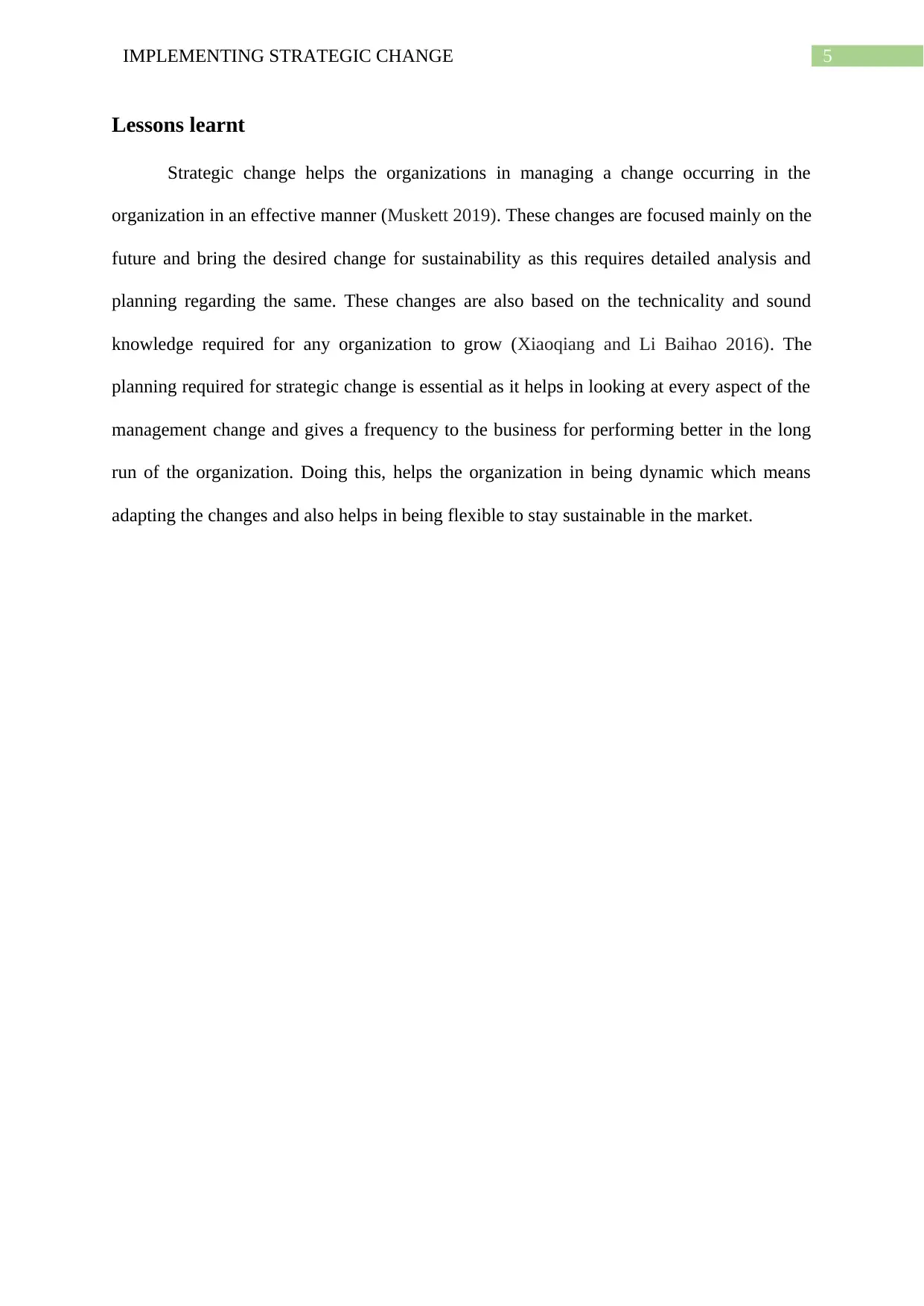
5IMPLEMENTING STRATEGIC CHANGE
Lessons learnt
Strategic change helps the organizations in managing a change occurring in the
organization in an effective manner (Muskett 2019). These changes are focused mainly on the
future and bring the desired change for sustainability as this requires detailed analysis and
planning regarding the same. These changes are also based on the technicality and sound
knowledge required for any organization to grow (Xiaoqiang and Li Baihao 2016). The
planning required for strategic change is essential as it helps in looking at every aspect of the
management change and gives a frequency to the business for performing better in the long
run of the organization. Doing this, helps the organization in being dynamic which means
adapting the changes and also helps in being flexible to stay sustainable in the market.
Lessons learnt
Strategic change helps the organizations in managing a change occurring in the
organization in an effective manner (Muskett 2019). These changes are focused mainly on the
future and bring the desired change for sustainability as this requires detailed analysis and
planning regarding the same. These changes are also based on the technicality and sound
knowledge required for any organization to grow (Xiaoqiang and Li Baihao 2016). The
planning required for strategic change is essential as it helps in looking at every aspect of the
management change and gives a frequency to the business for performing better in the long
run of the organization. Doing this, helps the organization in being dynamic which means
adapting the changes and also helps in being flexible to stay sustainable in the market.
⊘ This is a preview!⊘
Do you want full access?
Subscribe today to unlock all pages.

Trusted by 1+ million students worldwide
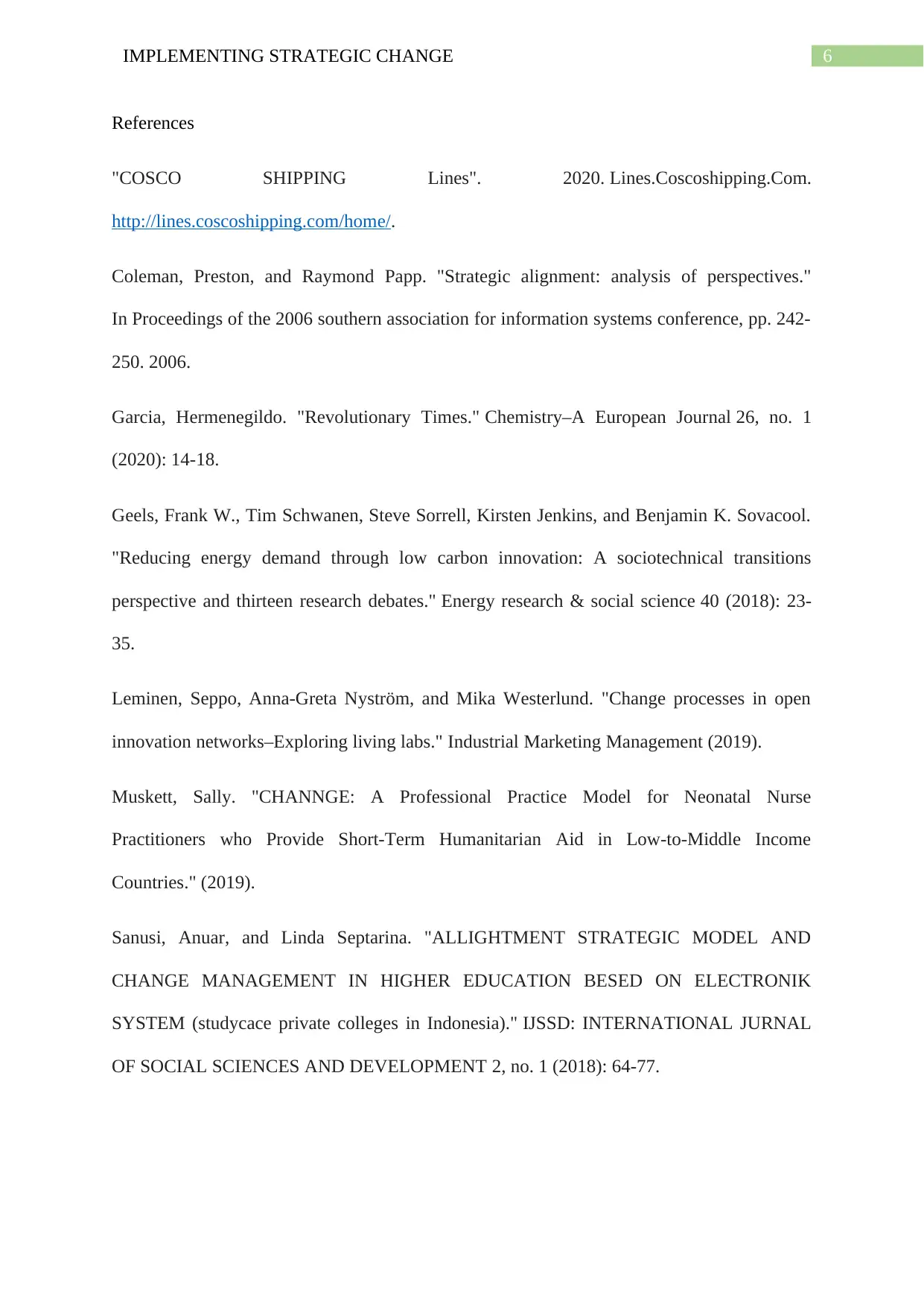
6IMPLEMENTING STRATEGIC CHANGE
References
"COSCO SHIPPING Lines". 2020. Lines.Coscoshipping.Com.
http://lines.coscoshipping.com/home/.
Coleman, Preston, and Raymond Papp. "Strategic alignment: analysis of perspectives."
In Proceedings of the 2006 southern association for information systems conference, pp. 242-
250. 2006.
Garcia, Hermenegildo. "Revolutionary Times." Chemistry–A European Journal 26, no. 1
(2020): 14-18.
Geels, Frank W., Tim Schwanen, Steve Sorrell, Kirsten Jenkins, and Benjamin K. Sovacool.
"Reducing energy demand through low carbon innovation: A sociotechnical transitions
perspective and thirteen research debates." Energy research & social science 40 (2018): 23-
35.
Leminen, Seppo, Anna-Greta Nyström, and Mika Westerlund. "Change processes in open
innovation networks–Exploring living labs." Industrial Marketing Management (2019).
Muskett, Sally. "CHANNGE: A Professional Practice Model for Neonatal Nurse
Practitioners who Provide Short-Term Humanitarian Aid in Low-to-Middle Income
Countries." (2019).
Sanusi, Anuar, and Linda Septarina. "ALLIGHTMENT STRATEGIC MODEL AND
CHANGE MANAGEMENT IN HIGHER EDUCATION BESED ON ELECTRONIK
SYSTEM (studycace private colleges in Indonesia)." IJSSD: INTERNATIONAL JURNAL
OF SOCIAL SCIENCES AND DEVELOPMENT 2, no. 1 (2018): 64-77.
References
"COSCO SHIPPING Lines". 2020. Lines.Coscoshipping.Com.
http://lines.coscoshipping.com/home/.
Coleman, Preston, and Raymond Papp. "Strategic alignment: analysis of perspectives."
In Proceedings of the 2006 southern association for information systems conference, pp. 242-
250. 2006.
Garcia, Hermenegildo. "Revolutionary Times." Chemistry–A European Journal 26, no. 1
(2020): 14-18.
Geels, Frank W., Tim Schwanen, Steve Sorrell, Kirsten Jenkins, and Benjamin K. Sovacool.
"Reducing energy demand through low carbon innovation: A sociotechnical transitions
perspective and thirteen research debates." Energy research & social science 40 (2018): 23-
35.
Leminen, Seppo, Anna-Greta Nyström, and Mika Westerlund. "Change processes in open
innovation networks–Exploring living labs." Industrial Marketing Management (2019).
Muskett, Sally. "CHANNGE: A Professional Practice Model for Neonatal Nurse
Practitioners who Provide Short-Term Humanitarian Aid in Low-to-Middle Income
Countries." (2019).
Sanusi, Anuar, and Linda Septarina. "ALLIGHTMENT STRATEGIC MODEL AND
CHANGE MANAGEMENT IN HIGHER EDUCATION BESED ON ELECTRONIK
SYSTEM (studycace private colleges in Indonesia)." IJSSD: INTERNATIONAL JURNAL
OF SOCIAL SCIENCES AND DEVELOPMENT 2, no. 1 (2018): 64-77.
Paraphrase This Document
Need a fresh take? Get an instant paraphrase of this document with our AI Paraphraser
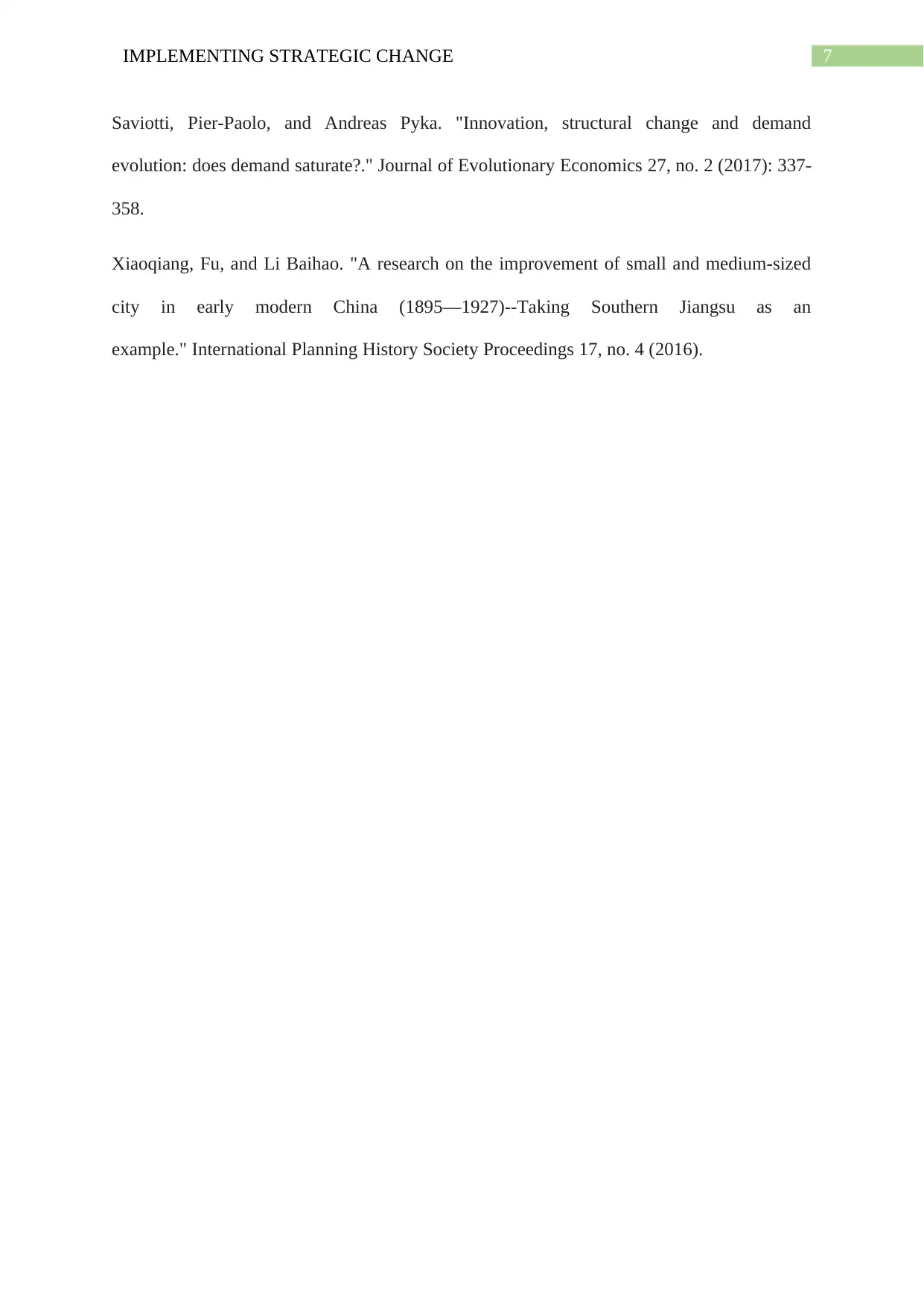
7IMPLEMENTING STRATEGIC CHANGE
Saviotti, Pier-Paolo, and Andreas Pyka. "Innovation, structural change and demand
evolution: does demand saturate?." Journal of Evolutionary Economics 27, no. 2 (2017): 337-
358.
Xiaoqiang, Fu, and Li Baihao. "A research on the improvement of small and medium-sized
city in early modern China (1895—1927)--Taking Southern Jiangsu as an
example." International Planning History Society Proceedings 17, no. 4 (2016).
Saviotti, Pier-Paolo, and Andreas Pyka. "Innovation, structural change and demand
evolution: does demand saturate?." Journal of Evolutionary Economics 27, no. 2 (2017): 337-
358.
Xiaoqiang, Fu, and Li Baihao. "A research on the improvement of small and medium-sized
city in early modern China (1895—1927)--Taking Southern Jiangsu as an
example." International Planning History Society Proceedings 17, no. 4 (2016).
1 out of 8
Related Documents
Your All-in-One AI-Powered Toolkit for Academic Success.
+13062052269
info@desklib.com
Available 24*7 on WhatsApp / Email
![[object Object]](/_next/static/media/star-bottom.7253800d.svg)
Unlock your academic potential
Copyright © 2020–2025 A2Z Services. All Rights Reserved. Developed and managed by ZUCOL.





